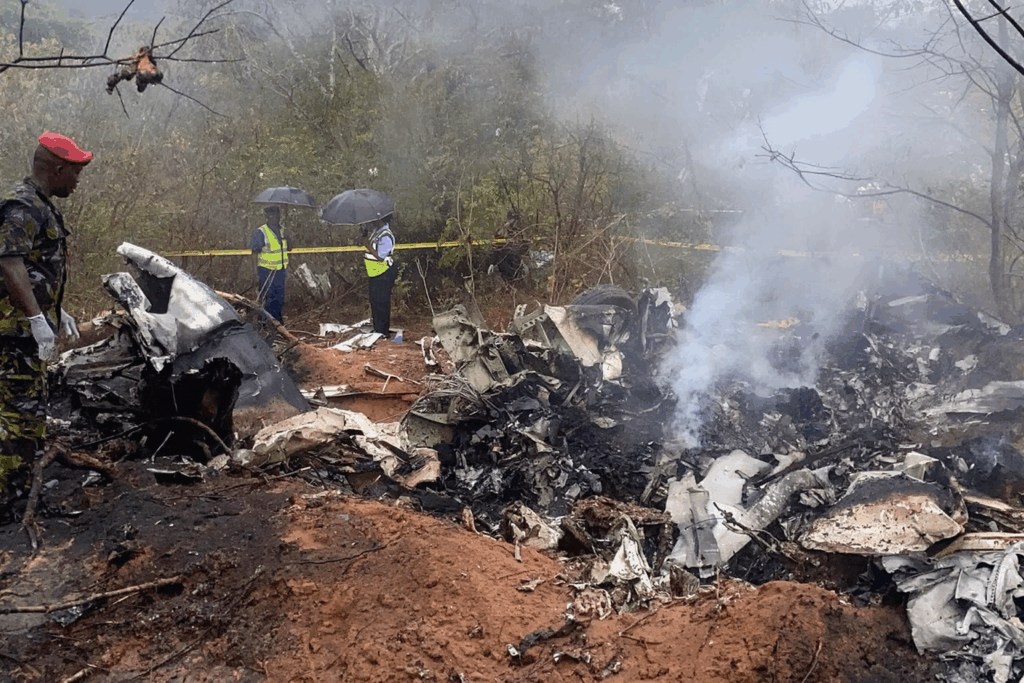A small charter plane carrying European tourists crashed Tuesday morning in Kenya’s Kwale County, killing all 11 on board and prompting calls for urgent improvements in aviation safety.
The flight, operated by Mombasa Air Safari and registered as 5Y-CCA, took off from the Diani Beach resort area and was en route to the Maasai Mara National Reserve when it went down in hilly, forested terrain about 40 kilometres (25 miles) from the Diani airstrip in Kwale County. The company confirmed 11 fatalities — eight Hungarian nationals, two Germans, and a Kenyan pilot.
Authorities say the crash occurred at around 5:30 a.m. local time, though some official reports cite 8:35 a.m. as the time of lost contact. The pilot reportedly did not communicate after departure, and air traffic control staff attempted to reach him for 30 minutes before the wreckage was located. Witnesses reported hearing a loud noise before arriving at a site where the aircraft had caught fire, and human remains were not immediately identifiable.
Kwale County Commissioner Stephen Orinde told the news agency that weather conditions at the time were “very misty” and that heavy rain had been falling over the region. “The weather is not very good here at the moment,” he said. “Since early in the morning, it is raining and it is very misty, but we cannot pre-empt [the findings].”
The aircraft, a single-engine Cessna 208B Grand Caravan, is a common workhorse for safari and short-haul flights in Kenya, but the crash spotlights deeper concerns about oversight of small-aircraft operations in the country. In its 2018 audit of Kenya’s safety oversight, the International Civil Aviation Organization noted Kenya fell below the global average in accident investigation performance.
Hungarian Prime Minister Viktor Orbán extended his condolences, stating, “What a tragedy! Our sincere condolences to the families of the Hungarians who died in the plane crash in Kenya.” Hungary’s foreign ministry added that the victims included two families and two children.
The incident also underscores the need to examine Kenya’s tourism infrastructure, where coastal beaches like Diani and inland safari destinations like the Maasai Mara are central to the national economy. Charter flights linking the coast to game reserves are common, and there are expectations of safety and reliability. One industry operator, speaking anonymously, said: “It’s a significant concern for our sector… Safety perception is important, particularly for international tourists.”
On the investigative front, authorities have dispatched teams to review flight data and radar records, maintenance logs, weather analysis, and possible communication failures. The Kenya Civil Aviation Authority (KCAA) has pledged cooperation and transparency. According to an aviation specialist via FlightGlobal, “Government agencies are already on site to establish the cause of the accident.”
While the full cause of Tuesday’s crash remains under investigation, the initial indicators — misty weather, missed radio contact, terrain, and charter-flight operations — raise concerns for aviation safety. Kenya faces questions about whether commercial demand and tourism have outpaced the infrastructure and regulations required for safe air travel in remote areas.
As the families of the victims proceed with repatriation and mourning, the local community in Kwale County reflects on the incident. “These are not just statistics,” Commissioner Orinde said. “They were visitors who came to experience the beauty of Kenya, and instead, their journey ended in sorrow.” A transparent, thorough investigation now represents the first step toward restoring confidence in Kenya’s aviation sector and its reputation as a travel destination.


